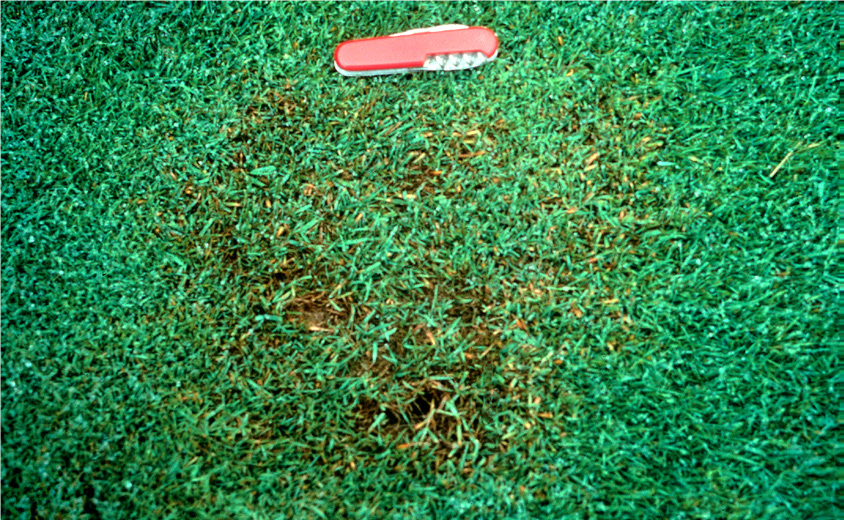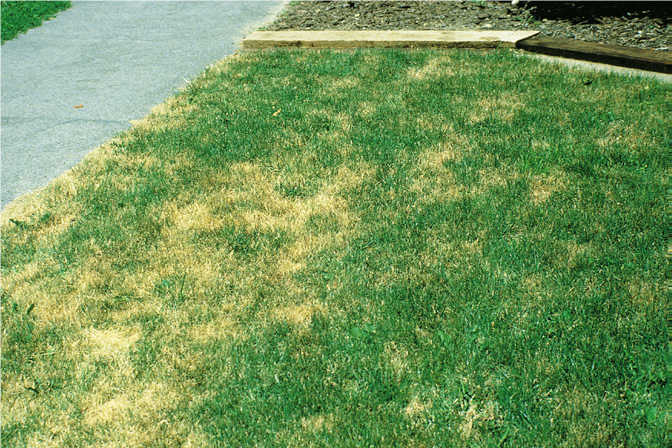Fungal leaf spots caused by Dreschslera spp. are common on bluegrass, bentgrasses, fescues, and ryegrasses.

Dernoeden; Reproduced, by permission, from R.W. Smiley, P.H.
Dernoeden, and B.B. Clarke. 2005. Compendium of Turfgrass Diseases,
3rd ed. American Phytopathological Society, St. Paul, MN.
Description
Bluegrass: On bluegrasses, the leaf spots are first seen as small, water-soaked areas that then turn dark brown to purplish black. As these spots increase in size, the centers turn brown and eventually fade to a light tan with purplish brown borders. The area surrounding the lesion is often yellow. As the lesions enlarge they often become elongated. The most significant damage comes from the crown and root decay phase of this disease. This occurs when the crown area becomes infected and the grass appears to be “melting” out. The overall disease pattern appears as a brownish melting-out of various size areas of turfgrass.
Bentgrasses: On bentgrasses, the disease is first seen as reddish brown, irregularly shaped patches varying from a couple inches to 4 feet in diameter. As leaves die in the infected areas, the patches often take on a smoky blue cast. Soon after, the grass turns yellow and dies. The first leaf symptoms are minute yellow flecks, which soon progress to irregularly-shaped, water-soaked blotches.
Fescue: On fescues, lesions are small, reddish brown, and irregularly shaped. Lesions eventually girdle the leaves causing dieback from the tip of the blade. Crown and roots are also affected, resulting in “melting” out symptoms.
Ryegrass: On ryegrasses, numerous small, dark brown, oval spots develop on the leaves. As the lesions age the centers turn to tan or white. Root and crown infections are also common.

Byther; Reproduced, by permission, from R.W. Smiley, P.H.
Dernoeden, and B.B. Clarke. 2005. Compendium of
Turfgrass Diseases, 3rd ed. AmericanPhytopathological
Society, St. Paul, MN.
Disease Cycle
The causal organism survives the winter in infected plants and infested debris. Roots, stems and rhizomes may be infected by mycelium in debris and soil. Infected leaf clipping are the primary source of infections, although spread can also occur via wind, rain, water, and equipment. Leaf spots occur mainly in the spring and autumn, but infection may occur at any time of year when the ground is not frozen. Leaf surfaces must be wet for infection to occur. Disease severity may increase with the onset of warm summer weather. A severe crown and root rot that reduces vigor and drought tolerance of the plants frequently accompanies the leaf spot phase of disease.
Management
IPM Strategies:
- Cultural Practices - To avoid moisture stress, water deeply, early in the day and as infrequently as possible. Maintain adequate fertility but avoid excessive nitrogen fertility, especially from early spring through midsummer. Mow grass as high as possible (lawns at 2-2.5”). Reduce thatch if greater than one inch, promote good air circulation, and plant resistant cultivars.
- Chemical Control - Systemic and protectant fungicides are registered for control of Dreschlera leaf spots. Consult your county Extension Educator or State Specialist for specific recommendations about pesticides and timing their application.

Credit: R. W. Smiley; Reproduced, by permission, from R.W. Smiley,
P.H. Dernoeden, and B.B. Clarke. 2005. Compendium of Turfgrass Diseases,
3rd ed. American Phytopathological Society, St. Paul, MN.

Stop! Read the label on every pesticide container each time before using the material. Pesticides must be applied only as directed on the label to be in compliance with the law. Contact the Division of Pesticide Control at (603) 271-3550 to check registration status. Dispose of empty containers safely, according to New Hampshire regulations.
Download the resource for the complete factsheet.

